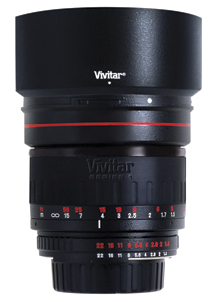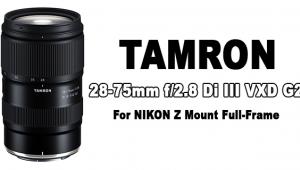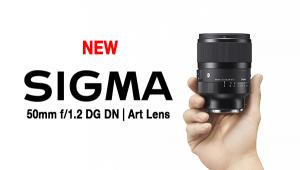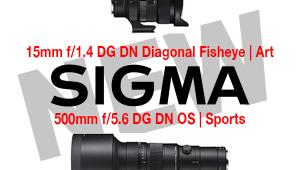Lenses: The Prime Accessory; Fast, Wide, And Wondrous
There’s an old saying that putting a new lens on your camera is like putting on a fresh pair of eyes. The latest lenses increasingly offer the ability to shoot in lower light without having to raise the ISO beyond quality limits, thanks to wider maximum apertures; shoot wider angles of view with APS-C sensor-size cameras; and allow for perspective control right in the camera.
 |
 |
||
|
|
There are those who would argue with the need for a tilt/shift lens in a day and age when you can make practically any such corrections in post. However, speaking from experience, I have to go by the old maxim, seeing is believing. So I find the two new Canon tilt/shift lenses a welcome addition. The new TS-E 24mm f/3.5L II (a replacement) and the TS-E 17mm f/4L give you greater control over perspective and depth of field in landscape and architectural photography, and are of course compatible with all Canon EOS system SLR cameras (they work best with full-frame sensors). Undoubtedly the optics have been improved on the 24mm optic, but what really impresses me is the even wider 17mm TS-E glass, which finally addresses the issue of trying to capture tall buildings without stepping back into traffic. An innovative feature on both lenses is Canon’s new TS Revolving System. Canon explains that this feature allows tilting and shifting lens movements to be adjusted in parallel or at right angles to each other. Additionally, once the TS Revolving System has been set, the orientation of the entire lens can be rotated freely. The amount of tilt is ±8.5? for the 24mm lens and ±6.5? for the 17mm lens. The amount of shift is ±12mm on both. In addition to the use of highly corrected lens elements, these optics boast a new anti-reflection coating to further minimize flare and ghosting. Such glass doesn’t come cheap: $2199 estimated retail for the TS-E 24mm f/3.5L II and $2499 estimated retail for the TS-E 17mm f/4L.
 |
 |
||
|
|
When used on digital Leica M models, the M8 and M8.2, the new Super-Elmar-M 18mm f/3.8 ASPH lens for the Leica M System effectively becomes a 24mm optic. In addition, the lens can also be used on all film Leica M camera models, where it retains the 18mm character. Vignetting and distortion have been effectively corrected. What’s more, the use of an aspherical element is said to reduce aberrations to a minimum and, we are told, allows the lens to be used at maximum aperture without undue effects. This lens comes with a screw-on rectangular lens hood that contributes to its compact size. A matching Leica Bright Line Finder M 18mm is also available for the new lens.
 |
 |
||
|
|
Nikon gave us a peek at what promises to be one of the more outstanding lens introductions this year—the AF-S DX Nikkor 10-24mm f/3.5-4.5G ED ($899 street—very reasonably priced). It has two ED and three aspherical glass elements, and comes with Silent Wave Motor AF with full manual override and internal focusing; lens hood included. Prior to this, Nikon also introduced the AF-S DX Nikkor 35mm f/1.8G (FX-format equivalent to 52mm). This lens should prove very useful for photojournalism and documentary photography in low-light conditions. It was designed to be lightweight, compact, and affordable ($199). It focuses down to 1 ft, and features Nikon’s exclusive Super Integrated Coating and Silent Wave Motor, with a rounded seven-blade diaphragm that contributes to more pleasing out-of-focus backgrounds.
Olympus continues to broaden the appeal of the Four Thirds system with the announcement of yet another lens, the Zuiko Digital 14-54mm f/2.8-3.5 II ($599 street), originally introduced at photokina. With a 35mm equivalent 28-108mm zoom range, this optic becomes practical as a portrait lens, for groups and individuals. It boasts High-Speed Imager AF support for Live View shooting and, owing to the lens diaphragm construction, should do a nice job rendering natural, out-of-focus backgrounds as a complement to the sharply focused subject.
 |
 |
||
|
|
Panasonic’s Lumix DMC-GH1 was announced along with two new lenses for the Micro Four Thirds system: the Lumix G Vario HD 14-140mm/F4.0-5.8 ASPH/MEGA O.I.S. and the Lumix G Vario 7-14mm/F4.0 ASPH. The 14-140mm (35mm = 28-280mm) incorporates an inner focus direct-drive linear motor for fast and silent focusing. This lens should prove useful for group portraits, some scenics, and wildlife portraits at the zoo. Add the 7-14mm (35mm = 14-28mm) and you’ve practically got all bases covered. This lens is ideal for landscapes and for dramatic perspectives with any subject. Both lenses feature highly corrected optics and the 14-140mm adds Optical Image Stabilization to maximize your shooting experience under all conditions. What’s more, Panasonic points out that in combination with the Lumix DMC-GH1, these lenses help you take advantage of the camera’s advanced contrast AF system, including Face Recognition. The seven aperture blades give backgrounds a more natural appearance when shooting at large apertures. And, of course, the lenses are multi-coated to reduce ghosting and flare.
 |
 |
||
|
|
- Log in or register to post comments

















































